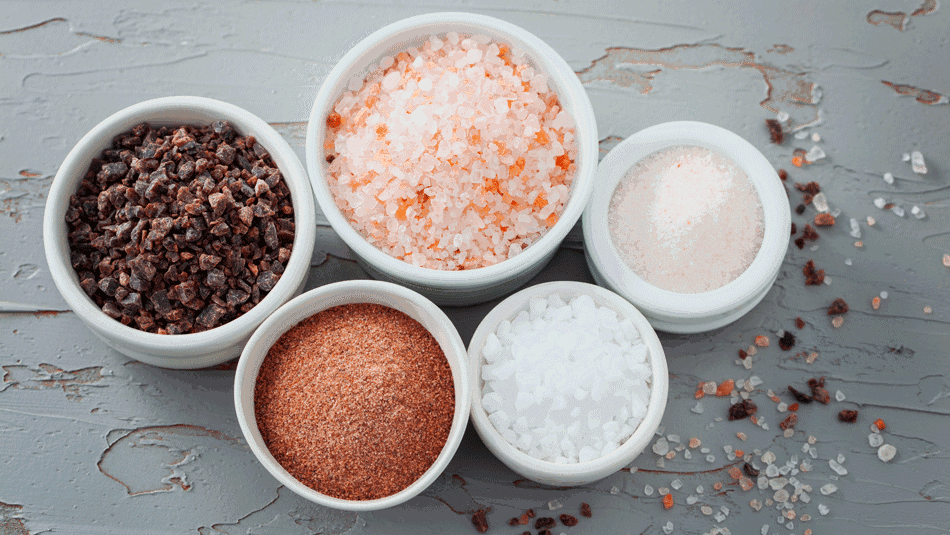We know pinch of salt can make or break a dish. Without this key ingredient, our food remains unexciting and flavourless. There are different type of salt used in cooking. Each type q some typical property which makes them different.
1. Table Salt or Iodised salt
The most common kind that is used in India, iodised salt, often known as the table salt, is the most easily available type of salt. This is because this form of salt gets easily dissolved in food. Deficiency of iodine leads to thyroid gland issues, hence, this salt is important but in measured quantities. According to WHO, iodine is essential for healthy brain development of children. The recommended consumption of iodine in adults over 18 years of age is 150 mcg everyday. Easiest way to provide Iodine supplement is to mix it with table salt.
We can avoid iodine deficiency by using a bit of regular iodized table salt every day,
2. Himalayan Salts
These occur in various colors due their predominant mineral content in their natural state. Both Sendha namak & Kala namak mentioned below are Himalayan rock salts.

Sendha namak (Himalayan rock salt).This is a large crystalline salt that’s harvested from the Punjab region of Pakistan. The crystals are off-white to white in color. Research shows that this type of salt may offer benefits for those with kidney disease. Some claim that Himalayan salt is more natural than table salt. This claim appears to have merit.
Table salt is usually heavily refined and mixed with anti-caking agents to prevent clumping, such as sodium aluminosilicate or magnesium carbonate,
Himalayan salt is less artificial and does not usually contain additives.
According to Ayurveda, Sendha namak is the best for eating
Kala namak (Black salt – Himalayan rock salt).

This is a dark, reddish-black crystalline salt that turns a grey to pinkish color when ground up. It has a distinct, sulfurous odor and taste.
Kala namak has a stronger and more pungent flavor while sendha namak is milder but still has character. Himalayan salt is essentially the same as “Sendha Namak”. Also these natural salts have a small amount of other minerals as well as a higher moisture content so spoon for spoon it has less sodium than processed salt
3.Kosher salt

Important for Jewish religion, Kosher salt is flaky and has longer grains. One major health benefit of this kind of salt is that it does not contain any additives like iodine. Once this gets dissolved in our food, its taste is not any different from regular salt. Using kosher salt to cut back on your sodium intake is recommended by many studies, as it can help prevent blood pressure and heart disease. As recommended by the U.S department of agriculture, consumption of kosher salt should be limited to below 2,300 mg everyday
3.Sea salt
Sea salt is made by evaporating seawater. It is unrefined, which means it contains more minerals like potassium, zinc, magnesium, calcium, and iron and also helps in enhancing the flavor of the dish.This salt does not dissolve easily.
4. Low-sodium salt
Sodium intakeTe a key ingredient in this kind of salt is potassium. Regular salts are rich in sodium and hence, low sodium salts are helpful for those with blood pressure problems. Low sodium salt contains 30 per cent less sodium than normal table salt
Eat Right

The aim of eat right movement of Fssai is to reduce the amount of salt you eat as much as possible, not to keep an exact tally of the amount you eat. (6g of salt a day is the maximum you should eat, and the less you eat the better.) The best approach is to try to always eat foods with the lowest salt level.
A 2016 report from the Centers for Disease Control and Prevention (CDC) states that over 90 percent of children and 89 percent of adults consume more than the recommended amount of sodium.
Sodium is necessary in small quantities, too much can have a negative impact on health.Those with kidney, heart, or liver issues, or people on a sodium-restricted diet, should monitor their sodium intake and limit their use of all salt, including pink Himalayan salt. Even people in good health should monitor sodium intake.





Leave a comment